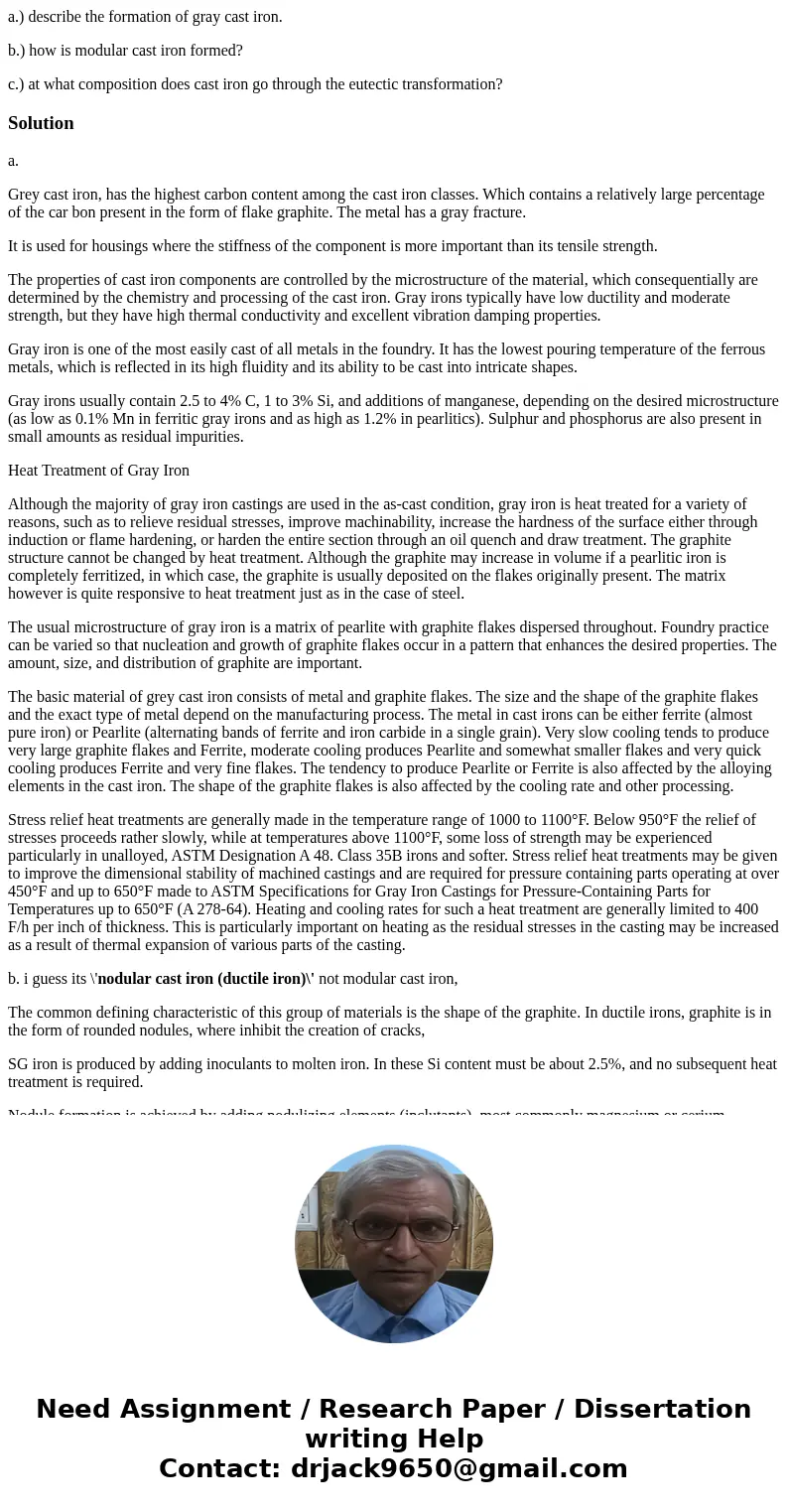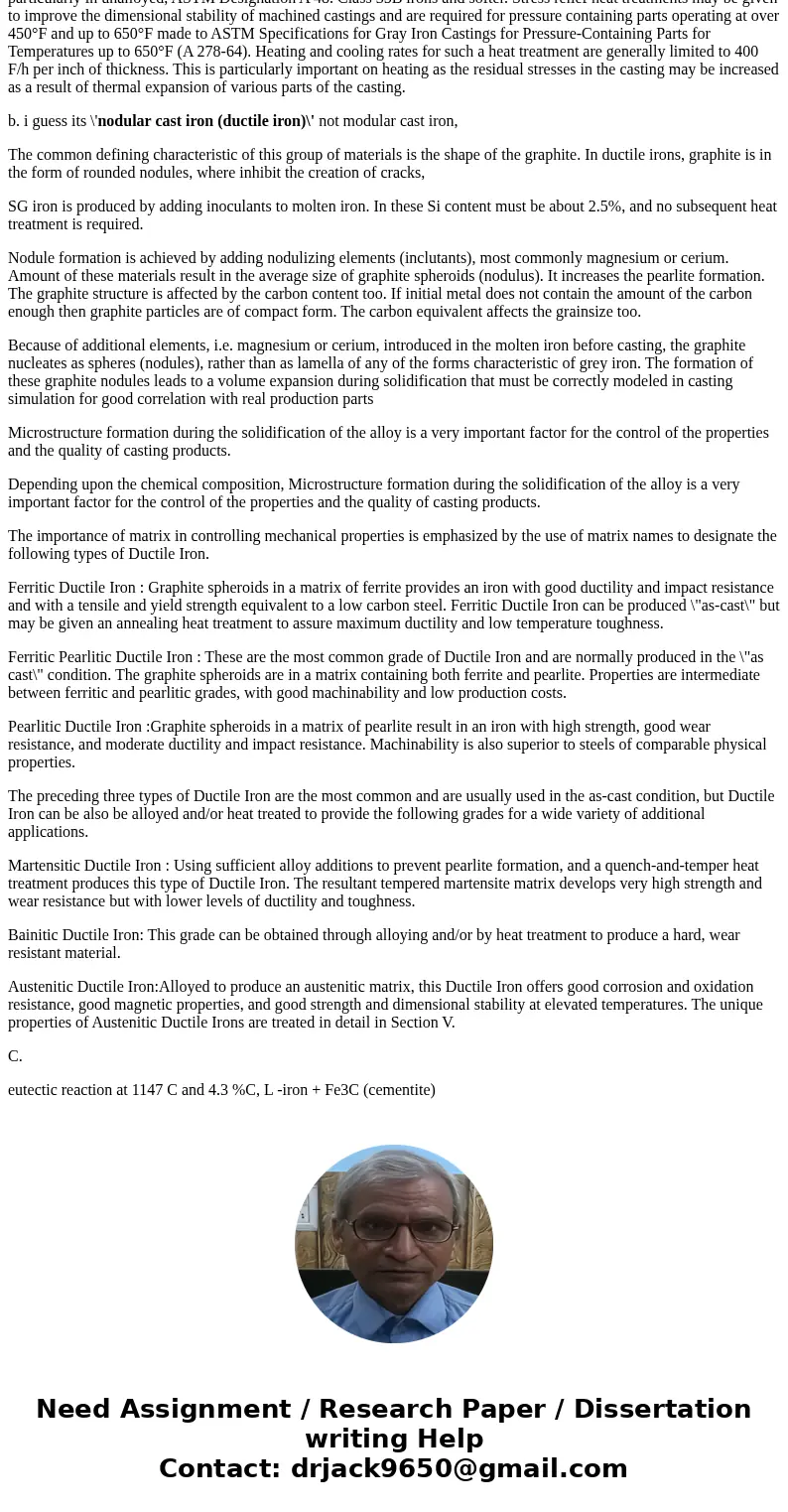a describe the formation of gray cast iron b how is modular
a.) describe the formation of gray cast iron.
b.) how is modular cast iron formed?
c.) at what composition does cast iron go through the eutectic transformation?
Solution
a.
Grey cast iron, has the highest carbon content among the cast iron classes. Which contains a relatively large percentage of the car bon present in the form of flake graphite. The metal has a gray fracture.
It is used for housings where the stiffness of the component is more important than its tensile strength.
The properties of cast iron components are controlled by the microstructure of the material, which consequentially are determined by the chemistry and processing of the cast iron. Gray irons typically have low ductility and moderate strength, but they have high thermal conductivity and excellent vibration damping properties.
Gray iron is one of the most easily cast of all metals in the foundry. It has the lowest pouring temperature of the ferrous metals, which is reflected in its high fluidity and its ability to be cast into intricate shapes.
Gray irons usually contain 2.5 to 4% C, 1 to 3% Si, and additions of manganese, depending on the desired microstructure (as low as 0.1% Mn in ferritic gray irons and as high as 1.2% in pearlitics). Sulphur and phosphorus are also present in small amounts as residual impurities.
Heat Treatment of Gray Iron
Although the majority of gray iron castings are used in the as-cast condition, gray iron is heat treated for a variety of reasons, such as to relieve residual stresses, improve machinability, increase the hardness of the surface either through induction or flame hardening, or harden the entire section through an oil quench and draw treatment. The graphite structure cannot be changed by heat treatment. Although the graphite may increase in volume if a pearlitic iron is completely ferritized, in which case, the graphite is usually deposited on the flakes originally present. The matrix however is quite responsive to heat treatment just as in the case of steel.
The usual microstructure of gray iron is a matrix of pearlite with graphite flakes dispersed throughout. Foundry practice can be varied so that nucleation and growth of graphite flakes occur in a pattern that enhances the desired properties. The amount, size, and distribution of graphite are important.
The basic material of grey cast iron consists of metal and graphite flakes. The size and the shape of the graphite flakes and the exact type of metal depend on the manufacturing process. The metal in cast irons can be either ferrite (almost pure iron) or Pearlite (alternating bands of ferrite and iron carbide in a single grain). Very slow cooling tends to produce very large graphite flakes and Ferrite, moderate cooling produces Pearlite and somewhat smaller flakes and very quick cooling produces Ferrite and very fine flakes. The tendency to produce Pearlite or Ferrite is also affected by the alloying elements in the cast iron. The shape of the graphite flakes is also affected by the cooling rate and other processing.
Stress relief heat treatments are generally made in the temperature range of 1000 to 1100°F. Below 950°F the relief of stresses proceeds rather slowly, while at temperatures above 1100°F, some loss of strength may be experienced particularly in unalloyed, ASTM Designation A 48. Class 35B irons and softer. Stress relief heat treatments may be given to improve the dimensional stability of machined castings and are required for pressure containing parts operating at over 450°F and up to 650°F made to ASTM Specifications for Gray Iron Castings for Pressure-Containing Parts for Temperatures up to 650°F (A 278-64). Heating and cooling rates for such a heat treatment are generally limited to 400 F/h per inch of thickness. This is particularly important on heating as the residual stresses in the casting may be increased as a result of thermal expansion of various parts of the casting.
b. i guess its \'nodular cast iron (ductile iron)\' not modular cast iron,
The common defining characteristic of this group of materials is the shape of the graphite. In ductile irons, graphite is in the form of rounded nodules, where inhibit the creation of cracks,
SG iron is produced by adding inoculants to molten iron. In these Si content must be about 2.5%, and no subsequent heat treatment is required.
Nodule formation is achieved by adding nodulizing elements (inclutants), most commonly magnesium or cerium. Amount of these materials result in the average size of graphite spheroids (nodulus). It increases the pearlite formation. The graphite structure is affected by the carbon content too. If initial metal does not contain the amount of the carbon enough then graphite particles are of compact form. The carbon equivalent affects the grainsize too.
Because of additional elements, i.e. magnesium or cerium, introduced in the molten iron before casting, the graphite nucleates as spheres (nodules), rather than as lamella of any of the forms characteristic of grey iron. The formation of these graphite nodules leads to a volume expansion during solidification that must be correctly modeled in casting simulation for good correlation with real production parts
Microstructure formation during the solidification of the alloy is a very important factor for the control of the properties and the quality of casting products.
Depending upon the chemical composition, Microstructure formation during the solidification of the alloy is a very important factor for the control of the properties and the quality of casting products.
The importance of matrix in controlling mechanical properties is emphasized by the use of matrix names to designate the following types of Ductile Iron.
Ferritic Ductile Iron : Graphite spheroids in a matrix of ferrite provides an iron with good ductility and impact resistance and with a tensile and yield strength equivalent to a low carbon steel. Ferritic Ductile Iron can be produced \"as-cast\" but may be given an annealing heat treatment to assure maximum ductility and low temperature toughness.
Ferritic Pearlitic Ductile Iron : These are the most common grade of Ductile Iron and are normally produced in the \"as cast\" condition. The graphite spheroids are in a matrix containing both ferrite and pearlite. Properties are intermediate between ferritic and pearlitic grades, with good machinability and low production costs.
Pearlitic Ductile Iron :Graphite spheroids in a matrix of pearlite result in an iron with high strength, good wear resistance, and moderate ductility and impact resistance. Machinability is also superior to steels of comparable physical properties.
The preceding three types of Ductile Iron are the most common and are usually used in the as-cast condition, but Ductile Iron can be also be alloyed and/or heat treated to provide the following grades for a wide variety of additional applications.
Martensitic Ductile Iron : Using sufficient alloy additions to prevent pearlite formation, and a quench-and-temper heat treatment produces this type of Ductile Iron. The resultant tempered martensite matrix develops very high strength and wear resistance but with lower levels of ductility and toughness.
Bainitic Ductile Iron: This grade can be obtained through alloying and/or by heat treatment to produce a hard, wear resistant material.
Austenitic Ductile Iron:Alloyed to produce an austenitic matrix, this Ductile Iron offers good corrosion and oxidation resistance, good magnetic properties, and good strength and dimensional stability at elevated temperatures. The unique properties of Austenitic Ductile Irons are treated in detail in Section V.
C.
eutectic reaction at 1147 C and 4.3 %C, L -iron + Fe3C (cementite)


 Homework Sourse
Homework Sourse